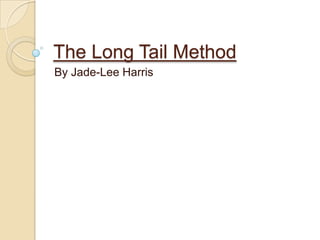Report
Share

Recommended
Recommended
Today, another wave of technological innovation has Furniture
World's point/counterpoint duo, Bill Napier and Ed Tashjian, thinking about the future of furniture shows, including that behemoth, the High Point Market.What is the future of furniture markets" Point/Counter Point Furniture World ...

What is the future of furniture markets" Point/Counter Point Furniture World ...Napier Marketing Group, LLC.
More Related Content
Similar to The long tail presentation
Today, another wave of technological innovation has Furniture
World's point/counterpoint duo, Bill Napier and Ed Tashjian, thinking about the future of furniture shows, including that behemoth, the High Point Market.What is the future of furniture markets" Point/Counter Point Furniture World ...

What is the future of furniture markets" Point/Counter Point Furniture World ...Napier Marketing Group, LLC.
Similar to The long tail presentation (20)
Managing the "Long Tail": How Focusing on Tail Spend Management Can Directly ...

Managing the "Long Tail": How Focusing on Tail Spend Management Can Directly ...
Despite or because of its ubiquity, advertising is not an easy term .docx

Despite or because of its ubiquity, advertising is not an easy term .docx
What is the future of furniture markets" Point/Counter Point Furniture World ...

What is the future of furniture markets" Point/Counter Point Furniture World ...
Recently uploaded
https://app.box.com/s/7hlvjxjalkrik7fb082xx3jk7xd7liz3TỔNG ÔN TẬP THI VÀO LỚP 10 MÔN TIẾNG ANH NĂM HỌC 2023 - 2024 CÓ ĐÁP ÁN (NGỮ Â...

TỔNG ÔN TẬP THI VÀO LỚP 10 MÔN TIẾNG ANH NĂM HỌC 2023 - 2024 CÓ ĐÁP ÁN (NGỮ Â...Nguyen Thanh Tu Collection
God is a creative God Gen 1:1. All that He created was “good”, could also be translated “beautiful”. God created man in His own image Gen 1:27. Maths helps us discover the beauty that God has created in His world and, in turn, create beautiful designs to serve and enrich the lives of others.
Explore beautiful and ugly buildings. Mathematics helps us create beautiful d...

Explore beautiful and ugly buildings. Mathematics helps us create beautiful d...christianmathematics
Recently uploaded (20)
TỔNG ÔN TẬP THI VÀO LỚP 10 MÔN TIẾNG ANH NĂM HỌC 2023 - 2024 CÓ ĐÁP ÁN (NGỮ Â...

TỔNG ÔN TẬP THI VÀO LỚP 10 MÔN TIẾNG ANH NĂM HỌC 2023 - 2024 CÓ ĐÁP ÁN (NGỮ Â...
Kodo Millet PPT made by Ghanshyam bairwa college of Agriculture kumher bhara...

Kodo Millet PPT made by Ghanshyam bairwa college of Agriculture kumher bhara...
Basic Civil Engineering first year Notes- Chapter 4 Building.pptx

Basic Civil Engineering first year Notes- Chapter 4 Building.pptx
UGC NET Paper 1 Mathematical Reasoning & Aptitude.pdf

UGC NET Paper 1 Mathematical Reasoning & Aptitude.pdf
ICT Role in 21st Century Education & its Challenges.pptx

ICT Role in 21st Century Education & its Challenges.pptx
Explore beautiful and ugly buildings. Mathematics helps us create beautiful d...

Explore beautiful and ugly buildings. Mathematics helps us create beautiful d...
ICT role in 21st century education and it's challenges.

ICT role in 21st century education and it's challenges.
Unit-V; Pricing (Pharma Marketing Management).pptx

Unit-V; Pricing (Pharma Marketing Management).pptx
Asian American Pacific Islander Month DDSD 2024.pptx

Asian American Pacific Islander Month DDSD 2024.pptx
The long tail presentation
- 1. The Long Tail Method By Jade-Lee Harris
- 2. Chris Anderson Currently the editor-in-chief of Californian Magazine “Wired”, which he took over in mid-2001.
- 3. He wrote The Long Tail theory which first appeared in Wired Magazine in October 2004. It later became a book which was published in early July 2006.
- 4. The Long Tail Theory is Like the Structure of a Dinosaur Long Tail highlights how our culture and economy is consistently increasing by moving away from a focus on a moderately small number of mainstream products and markets at the HEAD of the demand sector, and towards a popular number of niches in the TAIL.
- 5. The Theory’s Prediction: The demand for products unavailable in normal stores are potentially bigger than the demand of products traditionally found in normal stores.
- 6. For Example: Videos unavailable on broadcast TV on any given day. OR Songs not played on the radio.
- 7. Thus: Niche Rivalling the Hits Small Markets in Goods That DON’T Sell Well Enough for Traditional Retail and Broadcast Distribution. (Niche) VS Existing Large Markets in Goods That DO Sell Well Enough for Traditional Retail and Broadcast Distribution. (Hits)
- 8. TERM= Standard demand curve that can apply to any industry from entertainment to hard goods (applies to the orange bit). VERTICAL AXIS = Sales HORIZONTAL AXIS = Products RED HEAD= Hits that have dominated our markets and culture for most of the 20th Century. ORANGETAIL= The non-hits or niches which is where the new growth is coming from now and in the future.
- 9. Traditional retail economics claim that stores only stock the “likely” hits because shelf-space is expensive.
- 10. Online retailers like Amazon and iTunes can stock literally everything. Resulting in the number of available niche products to out-number the Hits by several orders of magnitude.
- 11. Those millions of niches are the LONG TAIL – largely neglected until recently.
- 12. When consumers are offered infinite choice their feedback highlights the true shape of demand.
- 13. The Long Tail theory has proven that results have turned out to favour the so-called “smaller market”.
- 14. WHY? Because people are attracted to niches - they satisfy the hunger for narrow interests better. And either way EVERYONE has a narrow interest.